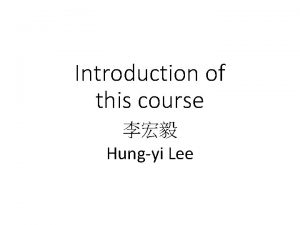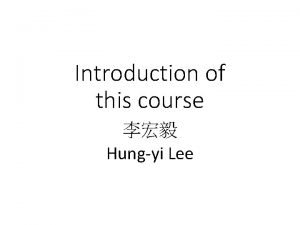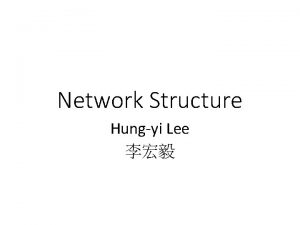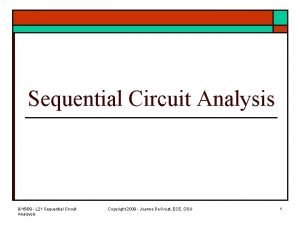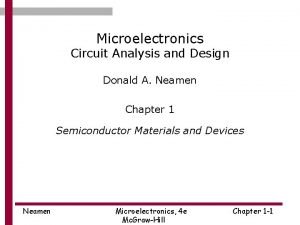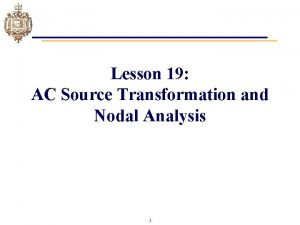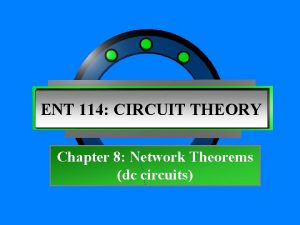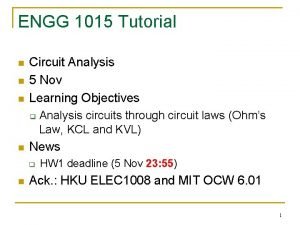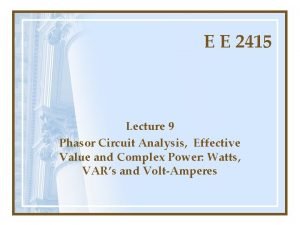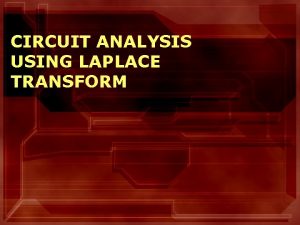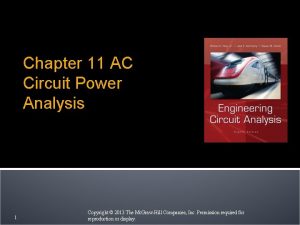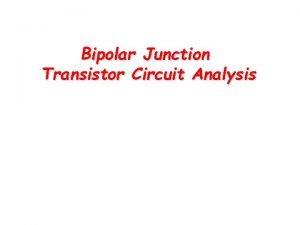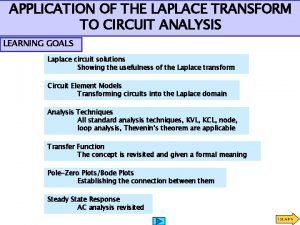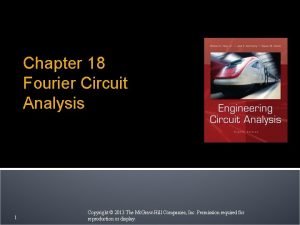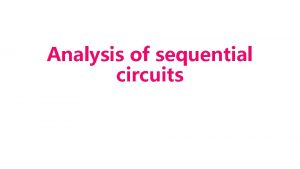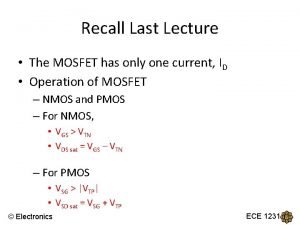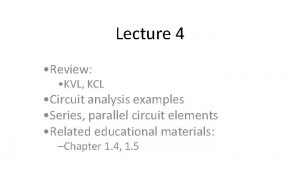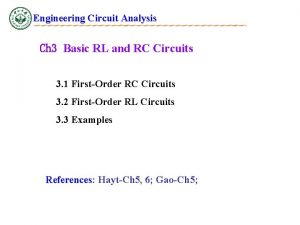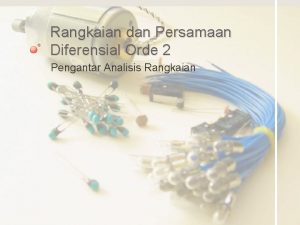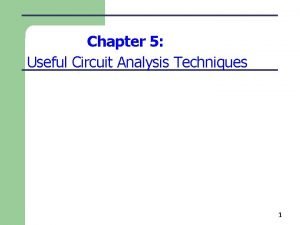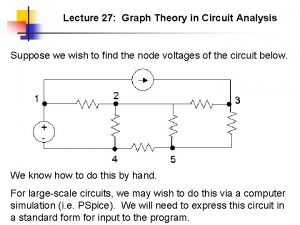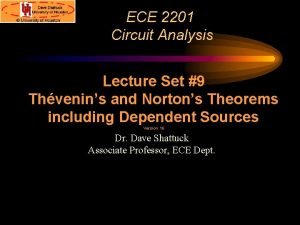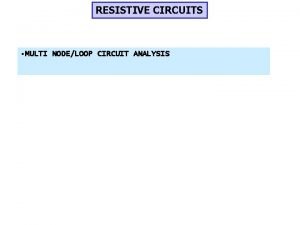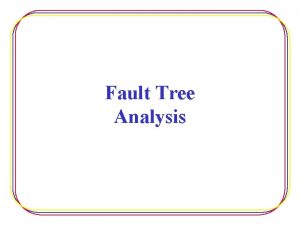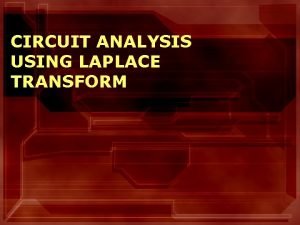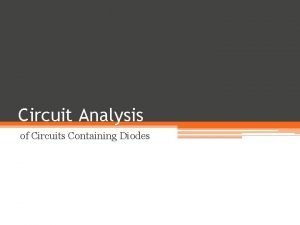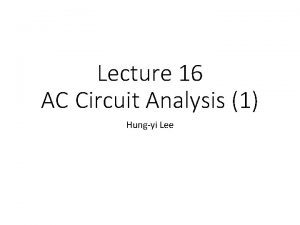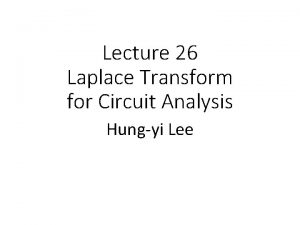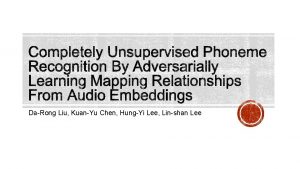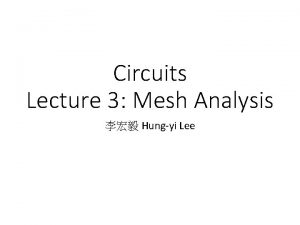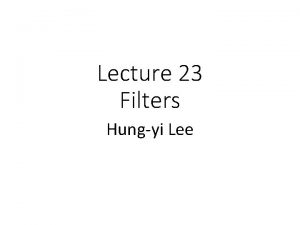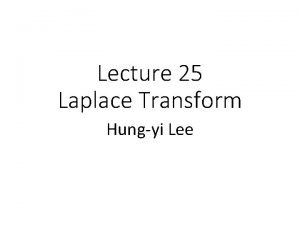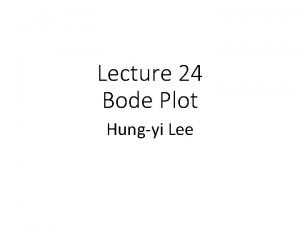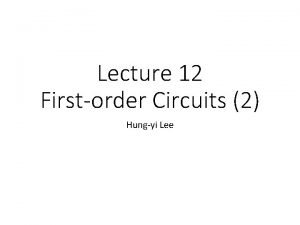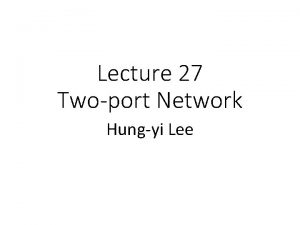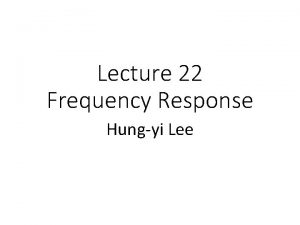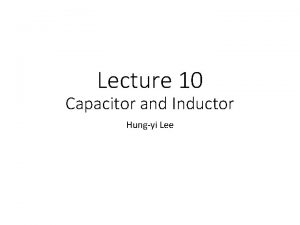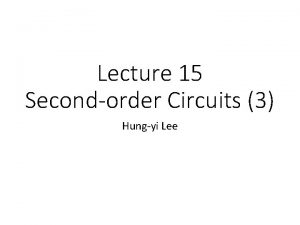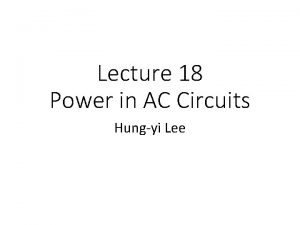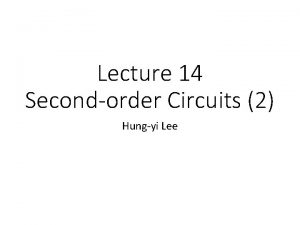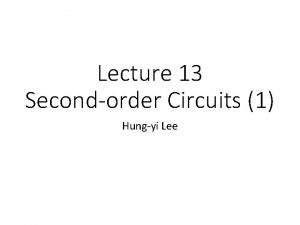Lecture 16 AC Circuit Analysis 1 Hungyi Lee






















































- Slides: 54

Lecture 16 AC Circuit Analysis (1) Hung-yi Lee

Textbook • Chapter 6. 1

AC Steady State Second order circuits: If the circuit is stable: As t → ∞ Steady State In this lecture, we only care about the AC steady state Source:

AC Steady State • Why we care about AC steady state? • Fourier Series/Fourier Transform

AC Steady State • Why we care about AC steady state? • Fourier Series/Fourier Transform • Most waveforms are the sum of sinusoidal waves with different frequencies, amplitudes and phases • Compute the steady state of each sinusoidal wave • Obtaining the final steady state by superposition

Example 6. 3

Example 6. 4

Example 6. 4

AC Steady-State Analysis Example 6. 3 Example 6. 4

AC Steady-State Analysis • AC steady state voltage or current is the special solution of a differential equation. • AC steady state voltage or current in a circuit is a sinusoid having the same frequency as the source. • This is a consequence of the nature of particular solutions for sinusoidal forcing functions. • To know a steady state voltage or current, all we need to know is its magnitude and its phase • Same form, same frequency

AC Steady-State Analysis • For current or voltage at AC steady state, we only have to record amplitude and phase Amplitude: Xm Phase: ϕ

Phasor • A sinusoidal function is a point on a x-y plane Polar form: Rectangular form: Exponential form:

Review – Operation of Complex Number A is a complex number

Review – Operation of Complex Number A is a complex number rectangular polar:

Review – Operation of Complex Number A is a complex number Complex conjugate:

Review – Operation of Complex Number Addition and subtraction are difficult using the polar form.

Review – Operation of Complex Number

Phasor Sinusoid function: Phasor: It is rotating. At t=0, the phasor is at Its projection on x-axis producing the sinusoid function


Phasor - Summation • KVL & KCL need summation Textbook, P 245 - 246

KCL and KVL for Phasors KCL KVL input current output current voltage rise voltage drop Phasors also satisfy KCL and KVL.

Phasor - Multiplication Time domain Phasor Multiply k

Phasor - Differential • We have to differentiate a sinusoidal wave due to the i-v characteristics of capacitors and inductors. Differentiate Multiplying jω

Phasor - Differential • We have to differentiate a sinusoidal wave due to the i-v characteristics of capacitors and inductors. Time domain Phasor

Phasor - Differential • We have to differentiate a sinusoidal wave due to the i-v characteristics of capacitors and inductors. Phasor Equivalent to multiply jω Multiply ω Rotate 90。 Differentiate on time domain = phasor multiplying jω

Phasor - Differential • Capacitor Time domain i leads v by 90。 Phasor

Phasor - Differential • Inductor Time domain v leads i by 90。 Phasor

Capacitor & Inductor For C, i leads v but v leads i for L

Phasor Time domain i-v characteristics Phasors satisfy Ohm's law for resistor, capacitor and inductor.

i-v characteristics Impedance Resistor Capacitor Inductor Admittance is the reciprocal of impedance.

Equivalent impedance and admittance Series equivalent impedance Parallel equivalent impedance

Impedance After series and parallel, the equivalent impedance is Resistor Capacitor Inductor Ø Inductors and capacitors are called reactive elements. Ø Inductive reactance is positive, and capacitive reactance is negative.

Impedance Triangle After series and parallel, the equivalent impedance is 33

AC Circuit Analysis • 1. Representing sinusoidal function as phasors • 2. Evaluating element impedances at the source frequency • Impedance is frequency dependent • 3. All resistive-circuit analysis techniques can be used for phasors and impedances • Such as node analysis, mesh analysis, proportionality principle, superposition principle, Thevenin theorem, Norton theorem • 4. Converting the phasors back to sinusoidal function.

Example 6. 6

Example 6. 7 • Impedance is frequency dependent Find equivalent network Zeq should be Zeq(ω) or Zeq(jω)

Example 6. 7 • Impedance is frequency dependent Find equivalent network If ω → 0 For DC, C is equivalent to open circuit If ω → ∞ C becomes short

Example 6. 8 Find v(t), v. L(t) and v. C(t)

Example 6. 8 Zeq = 4. 8 kΩ + j 6. 4 k Ω

Example 6. 8 Zeq = 4. 8 kΩ + j 6. 4 k Ω

Example 6. 8

Example 6. 8

Complete Response

Complete Response Reach steady state Forced Response

Complete Response Natural Response:

Complete Response

Complete Response Initial Condition:

Complete Response Reach steady state Forced Response

Complete Response Natural Response:

Complete Response Summarizing the results:

Three Terminal Network

Homework • 6. 20 • 6. 22 • 6. 24 • 6. 26 • 6. 36 (b)

Thank you!

Answer • 6. 20: 10, 0. 002 • 6. 22: Z=10Ω, v=40 cos 500 t, i 1=5. 66 cos(500 t-45。), i 2=4 cos(500 t+90。) • 6. 24: Z=7. 07<-45, i=1. 41 cos(2000 t+45 。), vc=14. 1 cos(2000 t-45。), v 1=10 cos(2000 t+90。) • 6. 26: Z=18 Ω, v=36 cos 2000 t, i. L=2 cos(2000 t-90。), i 2=2. 83 cos(2000 t+45。) • 6. 36 (b): L=12 m. H
 Hung-yi lee
Hung-yi lee Hungyi lee
Hungyi lee Hungyi lee
Hungyi lee Hungyi lee
Hungyi lee Hungyi lee
Hungyi lee 01:640:244 lecture notes - lecture 15: plat, idah, farad
01:640:244 lecture notes - lecture 15: plat, idah, farad Series vs parallel diagram
Series vs parallel diagram Parallel circuit with 3 bulbs
Parallel circuit with 3 bulbs Parallel circuit circuit construction kit
Parallel circuit circuit construction kit Voltage and current series parallel
Voltage and current series parallel What is complete and incomplete circuit
What is complete and incomplete circuit Parallel circuit short circuit
Parallel circuit short circuit Venn diagram of active and passive voice
Venn diagram of active and passive voice The circulatory system
The circulatory system Series parallel circuit current
Series parallel circuit current Tpcastt annabel lee
Tpcastt annabel lee Exploratory data analysis lecture notes
Exploratory data analysis lecture notes Sensitivity analysis lecture notes
Sensitivity analysis lecture notes Factor analysis lecture notes
Factor analysis lecture notes Analysis of algorithms lecture notes
Analysis of algorithms lecture notes Quadrant streak
Quadrant streak Zline 667-36
Zline 667-36 Analysis of sequential circuits
Analysis of sequential circuits Rangkaian sekuensial disebut juga
Rangkaian sekuensial disebut juga Op amp circuit analysis
Op amp circuit analysis Neamen
Neamen Source transformation circuit analysis
Source transformation circuit analysis Circuit theory theorems
Circuit theory theorems Vertical
Vertical Phasor circuit analysis example
Phasor circuit analysis example Inductor laplace
Inductor laplace Ac circuit power analysis
Ac circuit power analysis Dc analysis of bjt
Dc analysis of bjt Circuit analysis using laplace transform
Circuit analysis using laplace transform Fourier series circuit analysis
Fourier series circuit analysis Analysis of sequential circuit
Analysis of sequential circuit Drain current formula in mosfet
Drain current formula in mosfet Rangkaian linear
Rangkaian linear Kvl kcl examples
Kvl kcl examples Sequential circuit analysis
Sequential circuit analysis Engineering circuit analysis
Engineering circuit analysis Rangkaian homogen
Rangkaian homogen Circuit analysis techniques
Circuit analysis techniques Physical structure of transistor
Physical structure of transistor Circuit analysis
Circuit analysis Test source method circuit analysis
Test source method circuit analysis Resistive circuit analysis
Resistive circuit analysis Nasa fmea
Nasa fmea Find vo using mesh analysis
Find vo using mesh analysis Laplace inductor
Laplace inductor Circuit analysis with diodes
Circuit analysis with diodes Rhynosaurus
Rhynosaurus Cathrine helen spence
Cathrine helen spence Merdeka talks
Merdeka talks Lee vor luv beispiele
Lee vor luv beispiele
